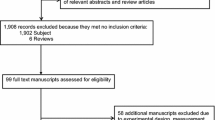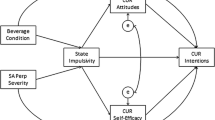Abstract
Alcohol use is a key risk factor for HIV infection among MSM, in part because intoxication may interfere with the use of prevention methods like condoms. However, few studies have examined whether this is due to alcohol’s pharmacological or expectancy effects or explored the specific aspects of sexual decision-making that may be affected. In this study, high-risk, heavy drinking MSM (N = 121) were randomly assigned to receive either (1) alcohol beverages, (2) placebo beverages, or (3) control beverages, before navigating a video-based sexual risk scenario that assessed several aspects of sexual decision-making. Results showed that condom use intentions and negotiation behaviors were lower among alcohol and placebo participants compared with controls, but that few significant differences emerged between the alcohol and placebo groups. These findings contrast with similar past studies, and suggest that alcohol’s expectancy effects may play a role in sexual decision-making.




Similar content being viewed by others
References
Beyrer C, Baral SD, van Griensven F, Goodreau SM, Chariyalertsak S, Wirtz AL, et al. Global epidemiology of HIV infection in men who have sex with men. Lancet. 2012;380:367–77.
Centers for Disease Control and Prevention. Trends in HIV diagnoses, 2005–2014 Atlanta, GA: U.S. Department of Health and Human Services; 2016. http://www.webcitation.org/6vAPQZG6c. Accessed 2 Nov 2017.
Centers for Disease Control and Prevention. Lifetime risk of HIV diagnosis Atlanta, GA: National Center for HIV/AIDS, Viral Hepatitis, STD, and TB Prevention; 2016. https://www.cdc.gov/nchhstp/newsroom/2016/croi-press-release-risk.html. Accessed 10 Dec 2017.
Centers for Disease Control and Prevention. Estimates of New HIV Infections in the United States. Atlanta, GA: National Center for HIV/AIDS, Viral Hepatitis, STD, and TB Prevention; 2016.
Centers for Disease Control and Prevention. HIV Prevention: Progress to Date. Atlanta, GA: U.S. Department of Health and Human Services; 2013.
Van der Elst EM, Mbogua J, Operario D, Mutua G, Kuo C, Mugo P, et al. High acceptability of HIV pre-exposure prophylaxis but challenges in adherence and use: qualitative insights from a phase I trial of intermittent and daily PrEP in at-risk populations in Kenya. AIDS Behav. 2013;17(6):2162–72.
Young I, McDaid L. How acceptable are antiretrovirals for the prevention of sexually transmitted HIV?: a review of research on the acceptability of oral pre-exposure prophylaxis and treatment as prevention. AIDS Behav. 2014;18(2):195–216.
McGowan I. Rectal microbicides: can we make them and will people use them? AIDS Behav. 2011;15(1):66–71.
Kirby T, Thornber-Dunwell M. Uptake of PrEP for HIV slow among MSM. Lancet. 2014;383(9915):399.
Smith D, Grant R, Weidle P, Lansky A, Mermin J, Fenton K. Interim guidance: preexposure prophylaxis for the prevention of HIV infection in men who have sex with men. MMWR Morb Mortal Wkly Rep. 2011;60(3):65–8.
Uthman OA. Global, regional, and national life expectancy, all-cause and cause-specific mortality for 249 causes of death, 1980–2015: a systematic analysis for the Global Burden of Disease Study 2015. Lancet. 2016;388(10053):1459–544.
Johnson NB, Hayes LD, Brown K, Hoo EC, Ethier KA. CDC National Health Report: leading causes of morbidity and mortality and associated behavioral risk and protective factors—United States, 2005–2013. MMWR Morb Mortal Wkly Rep. 2014;63:3–27.
Koblin BA, Husnik MJ, Colfax G, Huang Y, Madison M, Mayer K, et al. Risk factors for HIV infection among men who have sex with men. Aids. 2006;20(5):731–9.
Sander PM, Cole SR, Stall RD, Jacobson LP, Eron JJ, Napravnik S, et al. Joint effects of alcohol consumption and high-risk sexual behavior on HIV seroconversion among men who have sex with men. AIDS. 2013;27(5):815.
Baliunas D, Rehm J, Irving H, Shuper P. Alcohol consumption and risk of incident human immunodeficiency virus infection: a meta-analysis. Int J Pub Health. 2010;55(3):159–66.
Rehm J, Shield KD, Joharchi N, Shuper PA. Alcohol consumption and the intention to engage in unprotected sex: systematic review and meta-analysis of experimental studies. Addiction. 2012;107(1):51–9.
Shuper PA, Neuman M, Kanteres F, Baliunas D, Joharchi N, Rehm J. Causal considerations on alcohol and HIV/AIDS—a systematic review. Alcohol Alcohol. 2010;45(2):159–66.
Bruce D, Kahana S, Harper GW, Fernández MI. ATN t. Alcohol use predicts sexual risk behavior with HIV-negative or partners of unknown status among young HIV-positive men who have sex with men. AIDS Care. 2013;25(5):559–65.
Sen B. Does alcohol-use increase the risk of sexual intercourse among young people? Evidence from the NLSY97. J Health Econ. 2002;21:1085–93.
Grossman M, Markowitz S. I did what last night?! Adolescent risky sexual behaviors and substance use. East Econ J. 2005;31:383–405.
Vosburgh HW, Mansergh G, Sullivan PS, Purcell DW. A review of the literature on event-level substance use and sexual risk behavior among men who have sex with men. AIDS Behav. 2012;16(6):1394–410.
Kahler CW, Wray TB, Pantalone DW, Kruis RD, Mastroleo NR, Monti PM, et al. Daily associations between alcohol use and unprotected anal sex among heavy drinking HIV-positive men who have sex with men. AIDS Behav. 2015;19(3):422–30.
Dermen KH, Cooper ML. Sex-related alcohol expectancies among adolescents: I. Scale development. Psychol Addict Behav. 1994;8(3):152.
Leigh BC. The relationship of sex-related alcohol expectancies to alcohol consumption and sexual behavior. Addiction. 1990;85(7):919–28.
Jones BT, Corbin W, Fromme K. A review of expectancy theory and alcohol consumption. Addiction. 2001;96(1):57–72.
Darkes J, Goldman MS. Expectancy challenge and drinking reduction: process and structure in the alcohol expectancy network. Exp Clin Psychopharmacol. 1998;6(1):64.
Scott-Sheldon LA, Terry DL, Carey KB, Garey L, Carey MP. Efficacy of expectancy challenge interventions to reduce college student drinking: a meta-analytic review. Am Psychol Assoc. 2012;26:393.
Woolf-King SE, Maisto S, Carey M, Vanable P. Selection of film clips and development of a video for the investigation of sexual decision making among men who have sex with men. J Sex Res. 2010;47(6):589–97.
Scott-Sheldon LA, Carey KB, Cunningham K, Johnson BT, Carey MP, Team MR. Alcohol use predicts sexual decision-making: a systematic review and meta-analysis of the experimental literature. AIDS Behav. 2016;20(1):19–39.
Maisto SA, Palfai T, Vanable P, Heath J, Woolf-King S. The effects of alcohol and sexual arousal on determinants of sexual risk in men who have sex with men. Arch Sex Behav. 2012;41(4):971–86.
Centers for Disease Control and Prevention. Fact Sheet: Today’s HIV Epidemic Atlanta, GA: U.S. Department of Health and Human Services; 2016. http://www.webcitation.org/6vAPiBrwN. Accessed 2 Nov 2017.
Shuper PA, Joharchi N, Monti PM, Loutfy M, Rehm J. Acute alcohol consumption directly increases HIV transmission risk: a randomized controlled experiment. J Acquir Immune Defic Syndr. 2017;76(5):493–500.
National Institute on Alcohol Abuse and Alcoholism. Overview of Alcohol Consumption: Drinking Levels Defined Rockville, MD: U.S. Department of Health and Human Services; 2017. https://www.niaaa.nih.gov/alcohol-health/overview-alcohol-consumption/moderate-binge-drinking. Accessed 4 June 2018.
Skinner H. The drug abuse screening test. Addict Behav. 1982;7:363–71.
Donovan DM, Kivlahan DR, Doyle SR, Longabaugh R, Greenfield SF. Concurrent validity of the Alcohol Use Disorders Identification Test (AUDIT) and AUDIT zones in defining levels of severity among out-patients with alcohol dependence in the COMBINE study. Addiction. 2006;101(12):1696–704.
Saunders JB, Aasland OG, Babor TF, De la Fuente JR, Grant M. Development of the alcohol use disorders identification test (AUDIT): WHO collaborative project on early detection of persons with harmful alcohol consumption-II. Addiction. 1993;88(6):791–804.
Allen JP, Litten RZ, Fertig JB, Babor T. A review of research on the Alcohol Use Disorders Identification Test (AUDIT). Alcohol Clin Exp Res. 1997;21(4):613–9.
Reinert DF, Allen JP. The alcohol use disorders identification test (AUDIT): a review of recent research. Alcohol Clin Exp Res. 2002;26(2):272–9.
Yudko E, Lozhkina O, Fouts A. A comprehensive review of the psychometric properties of the Drug Abuse Screening Test. J Subst Abuse Treat. 2007;32(2):189–98.
Sobell LC, Sobell MB. Timeline follow-back. Measuring alcohol consumption. New York: Springer; 1992. p. 41–72.
Sobell LC, Brown J, Leo GI, Sobell MB. The reliability of the Alcohol Timeline Followback when administered by telephone and by computer. Drug Alcohol Depend. 1996;42(1):49–54.
Maisto SA, Conigliaro JC, Gordon AJ, McGinnis KA, Justice AC. An experimental study of the agreement of self-administration and telephone administration of the Timeline Followback interview. J Stud Alcohol Drugs. 2008;69(3):468–71.
Rueger SY, Trela CJ, Palmeri M, King AC. Self-administered web-based timeline followback procedure for drinking and smoking behaviors in young adults. J Stud Alcohol Drugs. 2012;73(5):829–33.
Schroder KE, Johnson CJ, Wiebe JS. Interactive voice response technology applied to sexual behavior self-reports: a comparison of three methods. AIDS Behav. 2007;11(2):313–23.
Wray TB, Kahler CW, Monti PM. Using ecological momentary assessment (EMA) to study sex events among very high-risk men who have sex with men (MSM). AIDS Behav. 2016;20(10):2231–42.
Gordon CM, Carey MP, Carey KB. Effects of a drinking event on behavioral skills and condom attitudes in men: implications for HIV risk from a controlled experiment. Health Psychol. 1997;16(5):490.
Helweg-Larsen M, Collins BE. The UCLA Multidimensional Condom Attitudes Scale: documenting the complex determinants of condom use in college students. Health Psychol. 1994;13(3):224.
Leigh BC. Alcohol expectancies and reasons for drinking: Comments from a study of sexuality. Psychol Addict Behav. 1990;4(2):91.
Crowne DP, Marlowe D. A new scale of social desirability independent of psychopathology. J Consult Psychol. 1960;24(4):349.
Reynolds WM. Development of reliable and valid short forms of the Marlowe–Crowne social desirability scale. J Clin Psychol. 1982;38(1):119–25.
George WH, Davis KC, Norris J, Heiman JR, Stoner SA, Schacht RL, et al. Indirect effects of acute alcohol intoxication on sexual risk-taking: the roles of subjective and physiological sexual arousal. Arch Sex Behav. 2009;38(4):498–513.
Fromme K, D’Amico EJ, Katz EC. Intoxicated sexual risk taking: an expectancy or cognitive impairment explanation? J Stud Alcohol Drugs. 1999;60(1):54.
Maisto SA, Carey MP, Carey KB. Effects of alcohol and expectancies on HIV-related risk perception and behavioral skills in heterosexual women. Exp Clin Psychopharmacol. 2004;12(4):288–97.
Maisto SA, Carey MP, Carey KB, Gordon CM. The effects of alcohol and expectancies on risk perception and behavioral skills relevant to safer sex among heterosexual young adult women. J Stud Alcohol. 2002;63(4):476–85.
Maisto SA, Carey MP, Carey KB, Gordon CM, Schum JL, Lynch KG. The relationship between alcohol and individual differences variables on attitudes and behavioral skills relevant to sexual health among heterosexual young adult men. Arch Sex Behav. 2004;33(6):571–84.
Curtin JJ, Fairchild BA. Alcohol and cognitive control: Implications for regulation of behavior during response conflict. J Abnorm Psychol. 2003;112(3):424–36.
Albarracin D, Johnson BT, Fishbein M, Muellerleile PA. Theories of reasoned action and planned behavior as models of condom use: a meta-analysis. Psychol Bull. 2001;127(1):142.
Schacht RL, Stoner SA, George WH, Norris J. Idiographically determined versus standard absorption periods in alcohol administration studies. Alcohol Clin Exp Res. 2010;34(5):925–7.
Acknowledgements
This manuscript was supported by P01AA019072 (to PM), L30AA023336 (to TW), K05AA019681 (to PM), and K08AA024056 (to MC) from the National Institute on Alcohol Abuse and Alcoholism.
Author information
Authors and Affiliations
Corresponding author
Ethics declarations
Conflicts of interest
The authors declare that they have no conflicts of interest.
Ethical Approval
All procedures performed in studies involving human participants were in accordance with the ethical standards of the institutional and/or national research committee and with the 1964 Helsinki Declaration and its later amendments or comparable ethical standards.
Informed Consent
Informed consent was obtained from all individual participants included in the study.
Rights and permissions
About this article
Cite this article
Wray, T.B., Celio, M.A., Pérez, A.E. et al. Causal Effects of Alcohol Intoxication on Sexual Risk Intentions and Condom Negotiation Skills Among High-Risk Men Who Have Sex with Men (MSM). AIDS Behav 23, 161–174 (2019). https://doi.org/10.1007/s10461-018-2243-x
Published:
Issue Date:
DOI: https://doi.org/10.1007/s10461-018-2243-x




